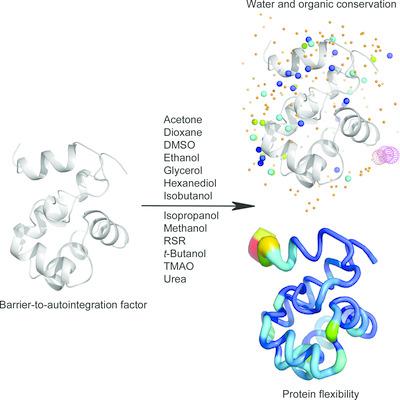当前位置:
X-MOL 学术
›
Acta Cryst. D
›
论文详情
Our official English website, www.x-mol.net, welcomes your
feedback! (Note: you will need to create a separate account there.)
Development of a structure‐analysis pipeline using multiple‐solvent crystal structures of barrier‐to‐autointegration factor
Acta Crystallographica Section D ( IF 2.6 ) Pub Date : 2020-10-08 , DOI: 10.1107/s2059798320011341 Sorabh Agarwal 1 , Mychal Smith 1 , Indhira De La Rosa 2 , Kliment A Verba 2 , Paul Swartz 2 , Miriam Segura-Totten 3 , Carla Mattos 1
Acta Crystallographica Section D ( IF 2.6 ) Pub Date : 2020-10-08 , DOI: 10.1107/s2059798320011341 Sorabh Agarwal 1 , Mychal Smith 1 , Indhira De La Rosa 2 , Kliment A Verba 2 , Paul Swartz 2 , Miriam Segura-Totten 3 , Carla Mattos 1
Affiliation

|
The multiple‐solvent crystal structure (MSCS) approach uses high concentrations of organic solvents to characterize the interactions and effects of solvents on proteins. Here, the method has been further developed and an MSCS data‐handling pipeline is presented that uses the Detection of Related Solvent Positions (DRoP) program to improve data quality. DRoP is used to selectively model conserved water molecules, so that an advanced stage of structural refinement is reached quickly. This allows the placement of organic molecules more accurately and convergence on high‐quality maps and structures. This pipeline was applied to the chromatin‐associated protein barrier‐to‐autointegration factor (BAF), resulting in structural models with better than average statistics. DRoP and Phenix Structure Comparison were used to characterize the data sets and to identify a binding site that overlaps with the interaction site of BAF with emerin. The conserved water‐mediated networks identified by DRoP suggested a mechanism by which water molecules are used to drive the binding of DNA. Normalized and differential B‐factor analysis is shown to be a valuable tool to characterize the effects of specific solvents on defined regions of BAF. Specific solvents are identified that cause stabilization of functionally important regions of the protein. This work presents tools and a standardized approach for the analysis and comprehension of MSCS data sets.
中文翻译:

使用势垒自积分因子的多溶剂晶体结构开发结构分析管线
多溶剂晶体结构(MSCS)方法使用高浓度的有机溶剂来表征溶剂对蛋白质的相互作用和影响。在这里,该方法得到了进一步发展,并提出了一种MSCS数据处理管道,该管道使用“相关溶剂位置检测”(DRoP)程序来提高数据质量。下降选择性地对保守的水分子进行建模,以便快速达到结构细化的高级阶段。这样可以更准确地放置有机分子,并且可以在高质量的图和结构上收敛。该流程已应用于染色质相关蛋白对自动整合因子的屏障(BAF),从而获得了结构模型优于平均统计数据。DRoP和Phenix结构比较用于表征数据集并鉴定与BAF与Emerin相互作用位点重叠的结合位点。DRoP鉴定的保守的水介导网络提出了一种机制,通过该机制水分子可用于驱动DNA结合。归一化和差分B因子分析被证明是表征特定溶剂对BAF定义区域的影响的有价值的工具。鉴定出导致蛋白质功能重要区域稳定的特定溶剂。这项工作提供了用于分析和理解MSCS数据集的工具和标准化方法。
更新日期:2020-10-08
中文翻译:

使用势垒自积分因子的多溶剂晶体结构开发结构分析管线
多溶剂晶体结构(MSCS)方法使用高浓度的有机溶剂来表征溶剂对蛋白质的相互作用和影响。在这里,该方法得到了进一步发展,并提出了一种MSCS数据处理管道,该管道使用“相关溶剂位置检测”(DRoP)程序来提高数据质量。下降选择性地对保守的水分子进行建模,以便快速达到结构细化的高级阶段。这样可以更准确地放置有机分子,并且可以在高质量的图和结构上收敛。该流程已应用于染色质相关蛋白对自动整合因子的屏障(BAF),从而获得了结构模型优于平均统计数据。DRoP和Phenix结构比较用于表征数据集并鉴定与BAF与Emerin相互作用位点重叠的结合位点。DRoP鉴定的保守的水介导网络提出了一种机制,通过该机制水分子可用于驱动DNA结合。归一化和差分B因子分析被证明是表征特定溶剂对BAF定义区域的影响的有价值的工具。鉴定出导致蛋白质功能重要区域稳定的特定溶剂。这项工作提供了用于分析和理解MSCS数据集的工具和标准化方法。











































 京公网安备 11010802027423号
京公网安备 11010802027423号